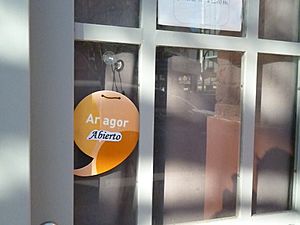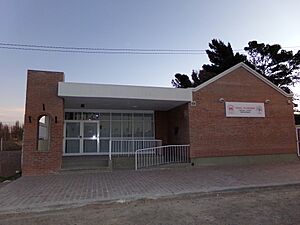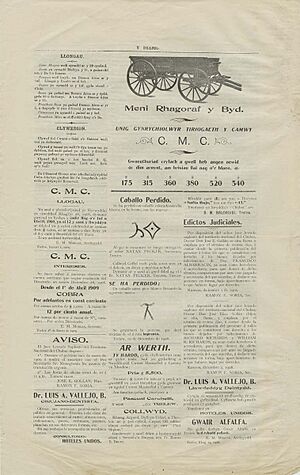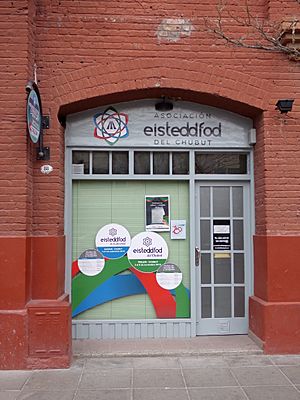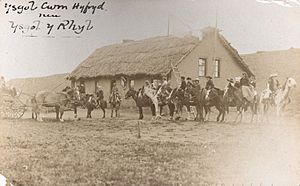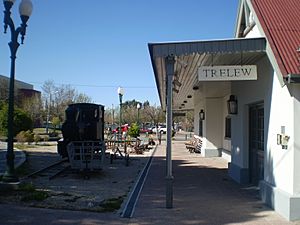Patagonian Welsh facts for kids
Quick facts for kids Patagonian Welsh |
||||
|---|---|---|---|---|
| Cymraeg y Wladfa | ||||
| Native to | Argentina | |||
| Region | Chubut | |||
| Native speakers | unknown (date missing) | |||
| Language family |
Indo-European
|
|||
| Writing system | Latin (Welsh alphabet) | |||
|
||||
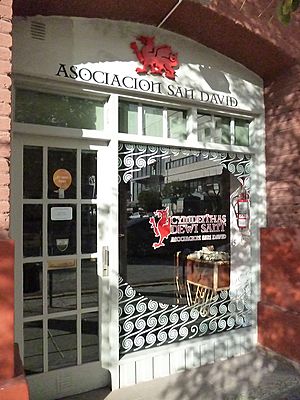
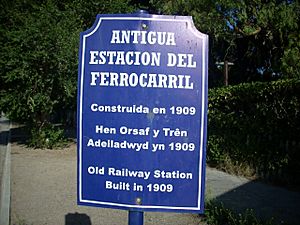
Patagonian Welsh (Welsh: Cymraeg y Wladfa) is a special kind of the Welsh language. People speak it in a place called Y Wladfa, which is a Welsh settlement in Patagonia, Chubut Province, Argentina. Did you know that the way we count in Welsh today (using a system based on 10) actually started in Patagonia in the 1870s? Wales later adopted this simpler way of counting in the 1940s.
Teachers travel to Patagonia to teach Welsh and train local people to become Welsh tutors. Knowing Welsh is seen as something special, even for people who aren't originally from Wales! Groups like the Welsh Government, British Council, Cardiff University, and the Welsh-Argentine Association help pay for Welsh lessons and projects there.
In 2005, there were 62 Welsh classes in the area. Welsh was also taught in two primary schools and two colleges near Gaiman. Today, there are special schools that teach both Welsh and Spanish, like Ysgol yr Hendre in Trelew and another college in Esquel. By 2016, Patagonia had three bilingual Welsh-Spanish primary schools.
Patagonian Welsh has become a unique version of the language. It is different from the Welsh spoken in Wales. However, people from Wales and Patagonia can still understand each other easily. Many place names in the Chubut Valley come from Welsh words. In 2015, 1,220 people took Welsh courses in Patagonia. The traditional Eisteddfod poetry competitions have also been brought back. Now, these competitions are held in both Welsh and Spanish.
Contents
History of Welsh in Patagonia
Welsh people first arrived in Patagonia in 1865. They moved there to protect their Welsh culture and language. They felt their way of life was in danger back in their home country of Wales. Over time, fewer people used the language. There was also not much contact between Wales and the Chubut Valley.
Things started to change in 1965. Many Welsh people visited the region to celebrate 100 years of the colony. Since then, more Welsh visitors have come to the area.
In 1945 and 1946, the BBC World Service even broadcast radio shows in Patagonian Welsh. During the 1982 Falklands war, some Welsh soldiers met Argentine soldiers who spoke Welsh. The Argentine troops were taken to Puerto Madryn.
In 2004, Welsh speakers in Argentina asked the Welsh government for Welsh TV shows. They hoped this would help the Welsh language survive and grow in Patagonia.
How the Language is Used Today
Learning Welsh in Patagonia
Around 2005, 62 Welsh classes were taught in Chubut. The language was also part of the lessons in a kindergarten, two primary schools, and two schools in the Gaiman area. This included a school that opened in 1899. There was also a bilingual Welsh-Spanish school in Trelew and a school in Esquel.
Welsh classes in the Andes mountains region have been held since 1996. The Welsh Institute of Trevelin and Esquel was created through a project involving the Assembly of Wales, the British Council, and the Chubut Province government.
Since the late 1990s, the Wales-Argentina Association has worked to increase Welsh teaching. This program has helped create a new group of Welsh speakers in Patagonia. These are mostly young people who learn Welsh as a second language. By 1997, most students were adults. There was only one school for children.
Four years later, there were 263 hours of Welsh classes each week. There were 846 students, and 87% of them were children and young people. In Gaiman, 95% of those taking classes were under twenty years old.
The Wales-Argentina Association also arranges trips for teachers and students. They help send Welsh teachers to Chubut. They also support students who attend a special Welsh language course each year. The association connects with colleges and schools in both Wales and Chubut. They provide help and money to students.
In May 2015, the local government of Trelew announced free Welsh classes. These intensive classes were for people living in the city. They were called Cwrs Blasu, which means "Savoring the language." Ann-Marie Lewis, a Welsh teacher, traveled to Patagonia just to teach these classes.
Bilingual Schools
For the 150th anniversary of the Welsh colony, a group in Trevelin started an association. Their goal was to create the first Spanish-Welsh bilingual school in the 16 de Octubre valley. It is called Ysgol Gymraeg yr Andes. This school is public but run privately.
Books and Newspapers
Poetry and literature books have been published since the early days of the colony. The first newspapers, like Y Drafod, started in the 1890s. Y Drafod was printed in both Welsh and Spanish.
One important writer from the colony was Eluned Morgan. She wrote several books, including Into the Andes (in Welsh: Dringo 'r Andes). These books are considered classics. R. Bryn Williams was another famous writer. He won a top prize at the National Eisteddfod. He also wrote several novels, such as Banddos de los Andes. More recently, Irma Hughes de Jones is a well-known writer.
Several books about life in Patagonia have been published. These include Memorias de la Patagonia (1980) by R. Bryn Williams. This book has essays by many people who lived in the colony. Atracciones de la Patagonia (1984) by Mariano Elías is based on interviews with Fred Green. Other books are Memories of Patagonia (1985) by Valmai Jones and Nel fach and bwcs (1992) by Margaret Lloyd Jones.
In 2005, Sian Eirian Rees Davies won a special prize for her historical novel I Fyd Sy Well. This book is about the start of the Welsh colony in Patagonia. Many books about the colony are available in both Spanish and Welsh.
Eisteddfod Festivals
The Eisteddfod is a very popular festival of music and literature in Wales. When the Welsh settlers came to Argentina, they started this festival there too. It is still celebrated twice a year today. In September, the Eisteddfod for young people is held in Gaiman. In October, the adult Eisteddfod takes place. Festivals are also held in Trevelin, Dolavon, and Puerto Madryn. The competitions are held in both Welsh and Spanish.
Unique Patagonian Welsh Words
The Welsh spoken in Patagonia has some words that come from Spanish or English. These words are not used in Wales.
For example, mynd i baseando comes from the Spanish word paseando. Baseando is a changed form of paseando.
| Patagonian Welsh | Welsh (Wales) | English | Rioplatense Spanish |
|---|---|---|---|
| Singlet | Fest | vest, singlet | chaleco |
| Poncin | Pwmpen | pumpkin | zapallo |
| Mynd i baseando | Mynd am dro | to go for a walk | ir de paseo / ir paseando |
| Corral | Corlan | sheepfold, corral | corral |
| Pasiwch | Dewch i mewn | enter! / come in! | ¡pase! |
| Costio | N/a | accost | costar |
Welsh Place Names in Patagonia
When the Welsh settlers arrived in Patagonia, they didn't immediately meet the native Tehuelche or Mapuche groups. These native groups already had their own names for places. So, the Welsh needed to name the landscapes of their new home.
Puerto Madryn was the first Welsh place name. The city's name honors Love Jones Parry, a Baron from Wales. This name came about in late 1862. That's when Love Jones Parry and Lewis Jones traveled to Patagonia. They sailed on the Candelaria ship to see if the area was good for a Welsh colony.
In the Chubut river valley, some village and rural area names came from the land itself. For example, Bryn Gwyn means "white hill," and Tyr Halen means "salt land." Other names came from farms given by the Argentine government or from chapels built in the area, like Bethesda or Ebenezer.
Some names honor people, like Trelew. "Lew" is a short form of Lewis Jones. Other names combine geographical features. For example, Dolavon means "meadow" or "lap" (Dol) and "river" (avon). Trevelin means "town" (Tre) and "mill" (velin), named after John Daniel Evans' flour mill.
Some Welsh names still exist today, while others have been forgotten. In 2015, a project called Gorsedd y Cwmwl started. It aims to bring back the original Welsh name for the Trono de las Nubes hill. The first Welsh settlers in the 16 de Octubre valley gave it this name, but it was forgotten. The mountain is also called «La Monja».
| Spanish | Welsh | English |
|---|---|---|
| Argentina | Yr Ariannin | The Argentina / Argentina |
| Arroyo de los Saltos | Nant y Fall (hybrid toponym, Welsh nant «stream», Eng. fall "cascade" or "jump") | Brook Jumps |
| Arroyo Pescado | Nant y Pysgod | Stream of the Fishes |
| Bajo de los Huesos | Pant yr Esgyrn | Bone Hollow |
| Cajón de Ginebra | Bocs Gin | Sorry Gin / Crate of Gin |
| Cañada Negra | Glyn Du | Black Glen |
| Cerro Cóndor | Craig yr Eryr | Eagle Hill |
| Cerro Ojo Negro | Trofa Llygad Du | Black Eye |
| Cerro Trono de las Nubes | Gorsedd y Cwmwl | Throne Cloud Hill |
| Dique Florentino Ameghino / El Dique | Yr Argae | The Dam / Florentino Ameghino Dam |
| Estepa patagónica | Y Paith (lit. the prairie) | Patagonian steppe |
| Fuerte Aventura | Caer Antur | Fort Adventure |
| La Angostura | Lle Cul | Narrow Place |
| Laguna de Aaron | Llyn Aaron | Aaron Lagoon |
| Laguna/Bajo del Diablo | Llyn y Gwr Drwg | Devil Lagoon |
| Laguna Grande | Llyn Mawr | Big Lagoon |
| Las Plumas | Dôl y Plu | Meadow of the Feathers |
| Loma Blanca | Bryn Gwyn | White Hill |
| Loma María | Bryniau Meri | Mary Hill |
| Loma Redonda | Bryn Crwn | Rounded Hill |
| Pampa de Agnia y Laguna de Agnia | Llyn Ania / Pant y Ffwdan | Ania Lake |
| Paso de Indios | Rhyd yr Indiaid | Ford of the Indians |
| Paso Berwyn | Rhyd Berwyn | Ford Berwyn |
| Península Valdés | Gorynys Valdés | Valdés Peninsula |
| Provincia del Chubut | Talaith Chubut / Camwy | Chubut Province |
| Provincia de Río Negro | Talaith Afon Ddu | Black River Province |
| Provincia de Santa Cruz | Talaith Y Groes Wen | Saint Cross Province |
| Pueblo de Luis | Trelew | Trelew / Lewtown |
| Pueblo del Molino | Trevelin | Mill Village |
| Puerto Madryn | Porth Madryn | Port Madryn |
| Punta Cuevas | Penrhyn yr Ogofâu | Caves Point |
| Rawson | Trerawson | Rawsontown |
| Río Chico | Afon Fach | Little River |
| Río Chubut | Afon Camwy | Swirling River |
| Río Corintos | Aber Gyrants (hybrid place name, Welsh aber "estuary", Eng. currants "Corinthian grape" with Welsh spelling and initial mutation) | Estuary of the Currants (N.B. NOT Currents) |
| Sierra Chata | Craig y Werfa | Rock Werfa |
| Tecka | Hafn Lâs | Canyon Lâs |
| Tierra Salada / Veintiocho de Julio | Tyr Halen | Salt Land |
| Torre José | Tŵr Joseph | Joseph Tower |
| Tres Sauces | Tair Helygen | Three Willow |
| Valle 16 de Octubre | Cwm Hyfryd / Bro Hydref | Beautiful Valley / October Valley |
| Valle de Los Altares | Dyffryn yr Allorau | Valley of the Altars |
| Valle de los Mártires | Dyffryn y Merthyron / Rhyd y Beddau | Valley of the Martyrs |
| Valle inferior del río Chubut | Dyffryn Camwy | Chubut Valley / Swirling Valley |
| Valle Frío | Dyffryn Oer | Cold Valley |
| Vuelta/Prado del río | Dolavon | Back River |
Images for kids
-
Tea house in Gaiman.
-
Closed (Spanish: Cerrado) / Ar Gau, Puerto Madryn.


